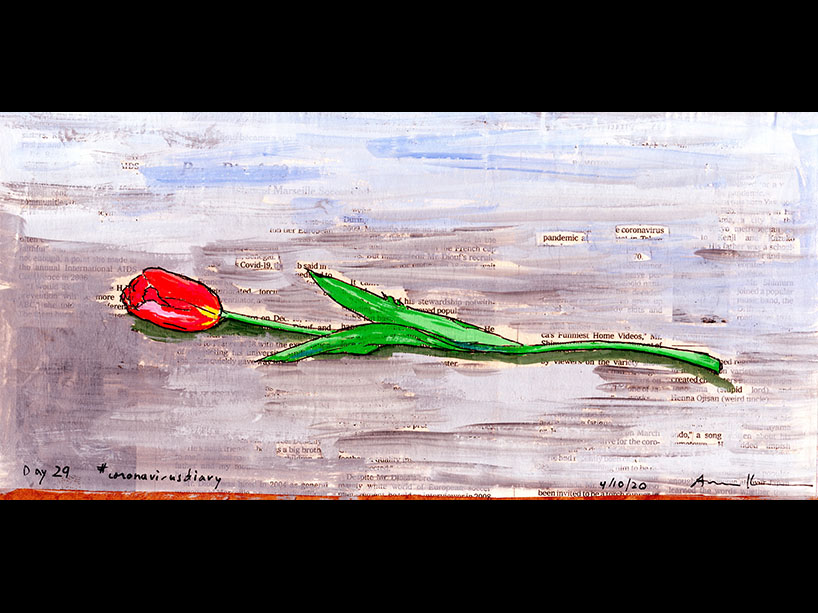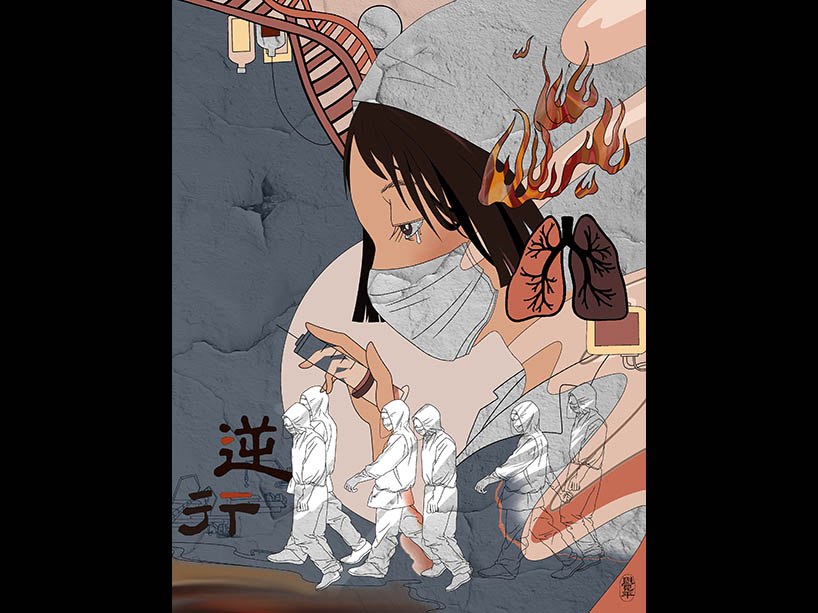New book examines human experience of pandemic life

Painting over text from the New York Times obituary section. Artist Amitava Kumar, created this piece, Coronavirusdiary Day 29, on April 10, 2020, that is featured on the cover of the book. Courtesy of the artist.
Living through the COVID-19 pandemic, literary and cultural critic professor Irene Gammel felt an immediate call to explore the experience and record its impact for the current and future scholars and students of social sciences and humanities.
Gammel, director of the university’s Modern Literature and Culture Research Centre in the Faculty of Arts, is the editor of a newly published book Creative Resilience and COVID-19, along with post-doctoral fellow and co-editor Jason Wang.
The book, seeking to capture the human experience of the pandemic through the lens of humanities and social sciences, including artistic expressions from visual art to interactive online diaries, was launched on April 14 via a Zoom event, allowing some of the international contributors to participate. The event was moderated by CBC anchor Kelda Yuen.
Twenty-three international experts and scholars from Canada, Germany, Kazakhstan, Sweden, the United Kingdom and the United States, wrote chapters that examined how creativity and resilience intersected with the individual and social impact of the pandemic.
The way humans express themselves through trauma and crisis transcends time, said Gammel, who recently studied a text featuring post-First World War artist, Mary Riter Hamilton who captured the human tragedy of the post-war battlefields on canvas.
“There are so many parallels,” said Gammel. “We see a direct connection with the narratives of trauma in earlier crises, when the media coverage was dominated by daily death statistics. These statistics are important, but they are abstract numbers that can obscure the trauma of loss. Art helps us understand the human element.”
The cover of the book highlights the artwork explored in one of the chapters, a visual response to COVID-19 by Indian American author Amitava Kumar, one of former President Barack Obama’s favourite writers. His artwork features a collage of words taken from obituaries from the New York Times overlaid with his painting of flowers brought home by his wife.

NYC-based writer and photographer Bill Hayes examined the pandemic through his photography, and was featured in Chapter 9 of the book: Threshold Spaces: Visualizing COVID-19 and the Resilient Power of the City. This photo, An L Train at Rush Hour, 5:05pm, was taken by April 22, 2020. Courtesy of the author.
One of the book’s chapters looks at an online diary created by writer Fang Fang in Wuhan, China, the epicentre of the pandemic in January and February 2020. “Diaries are traditionally very private,” said Wang. “But the diary genre shifted to the pandemic and it became a public and, at times, curatorial act. This and other diaries have become very public forms of communication and often include interactive components with their readers.”
Other chapters represent a range of topics examining the pandemic through arts, humanities, and social sciences including reflections on digital distractions during lockdown, examinations of how the pandemic impacted big city nightlife, and how minority groups lacked representation in media coverage of the pandemic.
Creative Resilience and COVID-19 builds on themes that emerged from a webinar series created and hosted by the Modern Literature and Culture Research Centre in response to the pandemic in 2020. The series, one of the longest cultural and arts-focused initiatives addressing the COVID-19 pandemic in Canada, engaged scholars, students and even the general public in regular live discussions online about social issues emerging as part of the collective experience of the pandemic.
“We needed to find new ways to create social togetherness,” said Gammel. “People responded well. In many of our webinars, we had over 100 participants.” Twenty-one webinars have been held so far with topics ranging from mental health and dating to human rights and cultural resilience.

When the pandemic began, Chinese artist Wang Jueping was isolated at home without access to paintbrushes or other materials and used her iPad to record her feelings and her appreciation for frontline workers through art. Her work is featured in the introduction of the book.
